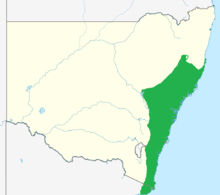Persoonia linearis
| Narrow-leaved geebung | |
|---|---|
 |
|
| Scientific classification | |
| Kingdom: | Plantae |
| (unranked): | Angiosperms |
| (unranked): | Eudicots |
| Order: | Proteales |
| Family: | Proteaceae |
| Genus: | Persoonia |
| Species: | P. linearis |
| Binomial name | |
|
Persoonia linearis Andrews |
|
 |
|
| Range of P. linearis in New South Wales and extending into Victoria in eastern Australia | |
| Synonyms | |
Persoonia breviuscula Gand.
Persoonia walteri Gand.
Pentadactylon angustifolium C.F.Gaertn.
Linkia linearis (Andrews) Kuntze
Persoonia angustifolia Knight [nom. illeg.]
Persoonia filifolia A.Dietr. [nom. illeg.]
Persoonia pentadactylon Steud. [nom. illeg.]
Persoonia linearis, commonly known as the narrow-leaved geebung, is a shrub native to New South Wales and Victoria in eastern Australia. It reaches 3 m (9.8 ft), or occasionally 5 m (16 ft), in height and has thick, dark grey papery bark. The leaves are, as the species name suggests, more or less linear in shape, and are up to 9 cm (3.5 in) long, and 0.1 to 0.7 cm (0.039 to 0.276 in) wide. The small yellow flowers appear in summer and autumn (December to May), followed by small green fleshy fruit known as drupes. Within the genus Persoonia, it is a member of the Lanceolata group of 58 closely related species. P. linearis interbreeds with several other species where they grow together.
Found in dry sclerophyll forest on sandstone-based nutrient-deficient soils, P. linearis is adapted to a fire-prone environment; the plants resprout epicormic buds from beneath their thick bark after bushfires. The fruit are consumed by vertebrates such as kangaroo, possums and currawongs. As with other members of the genus, P. linearis is rare in cultivation as it is very hard to propagate, either by seed or cuttings. It adapts readily to cultivation, preferring acidic soils with good drainage and at least a partly sunny aspect.
...
Wikipedia
